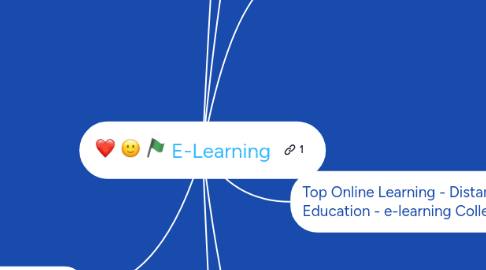E-Learning
by Harlens Exume


1. Introduction
1.1. Definition
1.2. What it Does?/ How it help Students
1.3. Facts
1.4. Common E-learning Websites
1.5. E-learning Online Colleges
1.6. Extras
2. What's E-Learning
2.1. The use of Internet technologies to deliver a broad array of solutions that enhance knowledge and performance
2.2. E-learning is Internet-enabled learning
2.3. Online Learning, aka (Also Known As) Online Education and Distance Education or e-learning, is when students learn using Internet resources. It is usually be totally online but when mixed with some F2F it is called blended or hybrid
2.4. Portable Learning
2.5. Convenient learning
3. Common Free Website that offer FREE Courses
3.1. Coursera
3.2. EdX
3.3. Class Central
3.4. Duolingo
3.5. KhanAcademy
3.6. CYBER DEGREES
4. Top Online Learning - Distance Education - e-learning Colleges
4.1. Grovo
4.2. Udemy
4.3. Curious
4.4. BigThink
4.5. The Floating University
5. To learn More
5.1. Oculture
5.2. US News and World reports: 8 Websites for Free Online Learning: Learn how to code, speak Spanish or brush up on statistics without paying a cent.Sept 2014
5.3. Use of MOOCs and Online Education is Exploding: Here's Why Dec 29, 2015 on LinkedIn This page is part of all courses taught by Maureen Greenbaum at Union County College updated: 3/5/2016
6. How We use Online Learning?
6.1. Online Learning is used from elementary grades, through High School, college and Graduate level students. e-learning is increasingly used due to many factors such as:
6.1.1. the difficulty of scheduling people to meet at the same time and place
6.1.2. the cost of travel
6.1.3. the cost of facilities (buildings,etc)
6.1.4. the availability of computer technology to produce personalized learning for tousands of students economically
6.1.5. the desire of students for control of their own learning: time,place and pace
6.1.6. the shortage of qualified teachers especially outside of 1st world countries
6.2. It can happen synchronously or asynchronously
7. Facts
7.1. One of newest forms of online education is the MOCC (Massively Open Online Course)
7.1.1. MOOCs are Free though for a small fee (under $100) offer a certificate upon completion, which is getting increasing credence via resume, portfolio and LinkedIn posting.
